
High speed spark photography
Tesladownunder, Tue Sept 05 2006, 02:48PMThis sort of follows on from the thead about End-on and broken sparks but has drifted into a new field for me. Here I look at spark photography in a rotating mirror particularly to examine the area of discontinuity frequently seen at the negative end of low intensity DC sparks.
Now this is interesting. This is taken through a rotating mirror. I joined a first surface laser mirror to one of my motors. Running at 2250RPM and with the spark 16cm away the radial velocity of the spark is 37m/s. With the image being only the negative 2cm of a total 7cm spark width, the vertical distance the same as the width of the spark is 500us. So you should see events in the region of 10us easily enough. There doesn't seem to be any structure at that level around the discontinuity.
Of course, with each spark lasting microseconds or less it becomes harder to catch a spark in the mirror. Even with 2 second exposures and the spark firing at perhaps 20Hz you only get a spark in view occasionally.
It should be easy to increase the resolution by a factor of 10 - 20 to see events at microsecond level. It may take many minutes of exposure to get a spark though.
This would be of great interest to Tesla coiling to get sparks seen on that time frame.
Note that this is not a true high speed photograph. Vertical movement of the spark on the image may be due to irregularity of the spark or due to events happening in time. Multiple spark channels should show up well or stepped leaders perhaps.
Peter
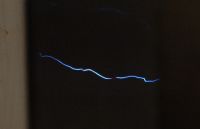
Re: High speed spark photography
Bjørn, Tue Sept 05 2006, 04:12PM
Do you have the .NEF RAW file?
Bjørn, Tue Sept 05 2006, 04:12PM
Do you have the .NEF RAW file?
Re: High speed spark photography
Tesladownunder, Tue Sept 05 2006, 06:39PM
I don't have software to manipulate the RAW files (I think) so I haven't set up to save pics as RAW.
I could try another camera but pics will be low quality compared to the Nikon.
Some other fast pics with 500us Vertical scale. There were a few partial shots where the spark is only seen one one side. I thought that this might have been end of shutter travel effects, however two examples on one shot make this unlikely. Could this be spark growth from a positive leader? This was seen several times.
The last two are slower pics at only 94RPM ie vertical scale is 12ms. My interpretation of the blur on the last pic is the ionization fading away after the spark ceases.
Peter
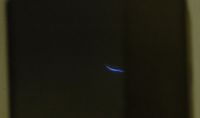
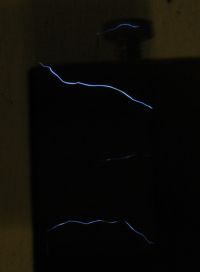

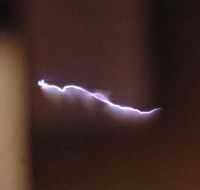
Tesladownunder, Tue Sept 05 2006, 06:39PM
I don't have software to manipulate the RAW files (I think) so I haven't set up to save pics as RAW.
I could try another camera but pics will be low quality compared to the Nikon.
Some other fast pics with 500us Vertical scale. There were a few partial shots where the spark is only seen one one side. I thought that this might have been end of shutter travel effects, however two examples on one shot make this unlikely. Could this be spark growth from a positive leader? This was seen several times.
The last two are slower pics at only 94RPM ie vertical scale is 12ms. My interpretation of the blur on the last pic is the ionization fading away after the spark ceases.
Peter




Re: High speed spark photography
Terry Fritz, Sat Sept 09 2006, 02:09AM
Hi TDU,
I am thinking of something like this:

The camera is just mounted to a base. A small square block is machined "well" and has four mirrors glued to its faces. Two 20,000 RPM hobby car motors spin it like mad. A lexan shild protects the camera if it gives way. I can mill the block to 0.001 inch and all so I think it will not tear up
At 20,000 RPM, the angulare velocity of the image is really double to 40,000 x 360 degrees per minute or 1 degree every 4uS At say 8 feet that is 0.4 inch per uS or 4 inches per cycle for a 100kHz coil!!! Should work!!
At say 8 feet that is 0.4 inch per uS or 4 inches per cycle for a 100kHz coil!!! Should work!!
Easy just to use two motors for mounting since another motor is simple and cheap like the Mabuchi Speed-550 here for $10...

Edmund has the mirrors:

Should be very easy to do and should work well I think. My old digital camera has manual focus too. Glad I paid $800 for it I even got it to work with Windows XP!! So I think it is a "go"
I even got it to work with Windows XP!! So I think it is a "go" 
Cheers,
Terry
Terry Fritz, Sat Sept 09 2006, 02:09AM
Hi TDU,
I am thinking of something like this:

The camera is just mounted to a base. A small square block is machined "well" and has four mirrors glued to its faces. Two 20,000 RPM hobby car motors spin it like mad. A lexan shild protects the camera if it gives way. I can mill the block to 0.001 inch and all so I think it will not tear up

At 20,000 RPM, the angulare velocity of the image is really double to 40,000 x 360 degrees per minute or 1 degree every 4uS
 At say 8 feet that is 0.4 inch per uS or 4 inches per cycle for a 100kHz coil!!! Should work!!
At say 8 feet that is 0.4 inch per uS or 4 inches per cycle for a 100kHz coil!!! Should work!!Easy just to use two motors for mounting since another motor is simple and cheap like the Mabuchi Speed-550 here for $10...

Edmund has the mirrors:

Should be very easy to do and should work well I think. My old digital camera has manual focus too. Glad I paid $800 for it
 I even got it to work with Windows XP!! So I think it is a "go"
I even got it to work with Windows XP!! So I think it is a "go" 
Cheers,
Terry
Re: High speed spark photography
Tesladownunder, Sat Sept 09 2006, 03:46AM
I was previously thinking that better resolution would be obtained at a greater distance. This of course only happens while your camera can enlarge the image to fit the feature size in the full screen. After that no benefit. By analogy 1 degree is millions of miles at the orbit of our most recently excommunicated planet, Pluto but if you can't focus a full screen there, forget it.
Accepting that means I get clearer pics and easier focus to make things full screen. Here is 100kHz with reasonable detail of the LED internals.

Tesladownunder, Sat Sept 09 2006, 03:46AM
I was previously thinking that better resolution would be obtained at a greater distance. This of course only happens while your camera can enlarge the image to fit the feature size in the full screen. After that no benefit. By analogy 1 degree is millions of miles at the orbit of our most recently excommunicated planet, Pluto but if you can't focus a full screen there, forget it.
Accepting that means I get clearer pics and easier focus to make things full screen. Here is 100kHz with reasonable detail of the LED internals.

Re: High speed spark photography
Terry Fritz, Sat Sept 09 2006, 04:25AM
Wow cool!! Are you able to focus your setup on a Tesla coil?
Maybe I don't have to bother. Although it would be a cool toy to have )
)
My cam has nice focus and zoom manual adjustments. I will have to figure them out )
)
Cheers,
Terry
Terry Fritz, Sat Sept 09 2006, 04:25AM
Here is 100kHz with reasonable detail of the LED internals
Wow cool!! Are you able to focus your setup on a Tesla coil?
Maybe I don't have to bother. Although it would be a cool toy to have
 )
)My cam has nice focus and zoom manual adjustments. I will have to figure them out
 )
)Cheers,
Terry
Re: High speed spark photography
Tesladownunder, Sun Sept 10 2006, 06:49AM
The weather is not the best for my TC at present but here is a pic of a Royer ZVS circuit firing a rewound inverter MOT transformer to give perhaps 2kV at 15kHz. It wasn't bright enough to show so I had to use a diode, resistor and .06uF Mica Cap to give a brighter spark which was rather irregular due to the low firing voltage.
Pic shows the setup before I added the cap. Second pic is 100 vertical pixels = 10us showing 3 sparks of less then 1us duration, which appear to deviate from a vertical line. Going back to the setup photo, you can see that one of the electrodes is vibrating changing the spark position.
The 3 sparks suggest that there is a resonance at about 10us period - 100kHz due to the .06uF cap and the effective series inductance of the cap itself plus the two 8 inch crocodile clip leads.
As you can judge by the pixellation (automatically smoothed by the software) plus the noise, the camera is being pushed to the limit. Very small sparks still seem to be point events. Hopefully a 2 foot TC spark will have more structure.
To see speed of light events I would need to have 500 foot events which would be 1us. In fact it would not be too hard to bounce a laser over a path this length to show the speed of light. Hmmm... I have a corner cube prism and two eight inch parallel first surface mirrors. Add a beam splitter or two, line it all up and go. Ohh, and it needs to have picosecond switching. Did I mention that Maybe my scanner Hex mirror assembly could rotate the laser beam to give fast enough effective switching. Head is starting to hurt here.
Maybe my scanner Hex mirror assembly could rotate the laser beam to give fast enough effective switching. Head is starting to hurt here.
Peter
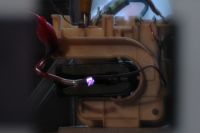
Tesladownunder, Sun Sept 10 2006, 06:49AM
The weather is not the best for my TC at present but here is a pic of a Royer ZVS circuit firing a rewound inverter MOT transformer to give perhaps 2kV at 15kHz. It wasn't bright enough to show so I had to use a diode, resistor and .06uF Mica Cap to give a brighter spark which was rather irregular due to the low firing voltage.
Pic shows the setup before I added the cap. Second pic is 100 vertical pixels = 10us showing 3 sparks of less then 1us duration, which appear to deviate from a vertical line. Going back to the setup photo, you can see that one of the electrodes is vibrating changing the spark position.
The 3 sparks suggest that there is a resonance at about 10us period - 100kHz due to the .06uF cap and the effective series inductance of the cap itself plus the two 8 inch crocodile clip leads.
As you can judge by the pixellation (automatically smoothed by the software) plus the noise, the camera is being pushed to the limit. Very small sparks still seem to be point events. Hopefully a 2 foot TC spark will have more structure.
To see speed of light events I would need to have 500 foot events which would be 1us. In fact it would not be too hard to bounce a laser over a path this length to show the speed of light. Hmmm... I have a corner cube prism and two eight inch parallel first surface mirrors. Add a beam splitter or two, line it all up and go. Ohh, and it needs to have picosecond switching. Did I mention that
 Maybe my scanner Hex mirror assembly could rotate the laser beam to give fast enough effective switching. Head is starting to hurt here.
Maybe my scanner Hex mirror assembly could rotate the laser beam to give fast enough effective switching. Head is starting to hurt here.Peter

Print this page